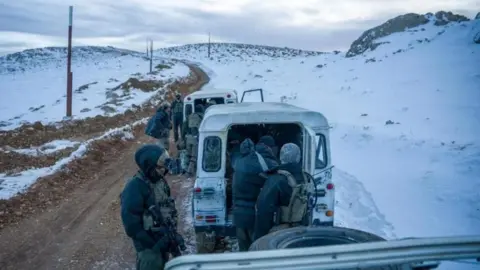 Reuters
ReutersAfter launching hundreds of air strikes on Syrian military assets and seizing positions including the summit of a mountain with an uninterrupted sightline to the capital Damascus, Israel appears to be taking advantage of what it sees as a unique moment of opportunity.
Syrian command structures were in disarray, with key positions apparently left unmanned after the fall of the Assad regime.
The Israel Defense Forces (IDF) says its air force and navy have conducted more than 350 strikes since Saturday night, taking out an estimated 70-80% of Syrian strategic military assets from Damascus to Latakia.
They included fighter aircraft, radar and air defence sites, and naval ships, as well as weapons stockpiles, the IDF said.
“The navy operated last night to destroy the Syrian fleet with great success,” said Defence Minister Israel Katz.
The IDF has also moved ground forces east from the Israeli-occupied Golan Heights into a demilitarised buffer zone in Syria and, it now admits, just beyond.
Katz said he had told the military to “establish a sterile defence zone free of weapons and terrorist threats in southern Syria, without a permanent Israeli presence”.
One Israeli commentator said the past 72 hours had “stood out even for people who thought they had already seen everything”.
“It didn’t strip the Syrian military of specific capabilities only – it sent it back to the starting line, bereft of any significant strategic capabilities,” wrote Yoav Limor in the Israel Hayom newspaper.
“The IDF operation to destroy Syria’s military capabilities is the largest it has ever undertaken,” commented Udi Etzion on the Walla news site.
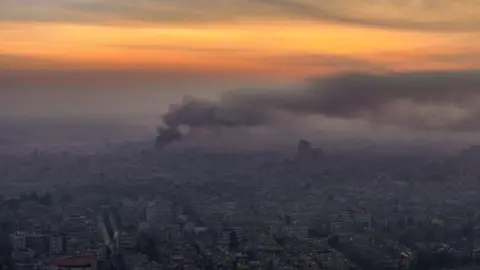 Getty Images
Getty ImagesFormer Israeli Air Force officers commented in online posts that some of the attacks carried out as part of this operation were based on plans drawn years ago.
One military analyst said that some targets were already identified by Israel in the mid-1970s.
Meanwhile, troops have taken control of positions in the Golan, including the top of Mt Hermon, according to Israeli media. In Arabic, the mountain is known as Jabal al-Sheikh.
“The territory guarantees strategic control over the whole southern Syrian arena, which generates an immediate threat to Israel,” the Ynet news website quoted Kobi Michael, a researcher at Israel’s Institute for National Security Studies (INSS), as saying. “There is no higher vantage point than the Syrian part of the Golan.”
Officials stress that Israel has been acting in its own national security interests following the collapse of the Assad regime.
They say the aim is to stop weapons that the regime held falling into the wrong hands – whether Syrian extremist factions or its old foe, the Lebanese armed group Hezbollah. Hezbollah and its backer, Iran, were close allies of Assad, helping him to prop him up in office during the long civil war in Syria.
“We will not allow an extreme Islamic terrorist entity to act against Israel beyond its border, putting its citizens at risk,” Prime Minister Benjamin Netanyahu said in a video message on Tuesday.
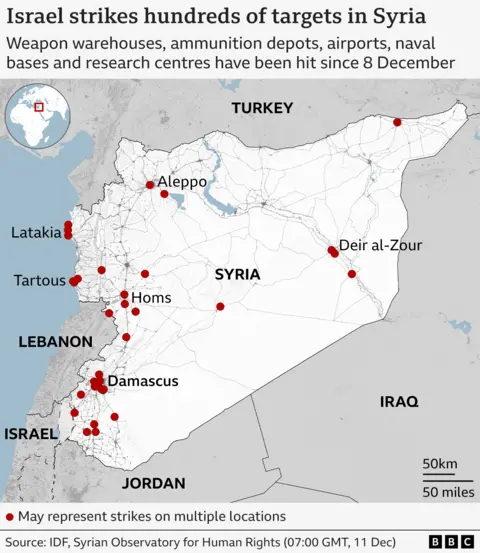
Syria and Israel fought against each other in the Middle East Wars of 1948, 1967 and 1973 and formally regard each other as enemy states.
Under Bashar al-Assad, Syria was a significant regional military power. Israel had attacked it in recent years in hundreds of strikes that were rarely openly acknowledged. Israel’s calculation included a sphere of deniability for itself but also for Assad so he would not feel forced to respond.
These had focused on preventing transfer of weapons to Hezbollah, as the main transport route was overland from Syria to Lebanon, arms manufacturing, and Syrian air defence systems, which posed a threat to Israeli warplanes sent on missions.
Israel avoided major attacks that could have led to wider war and sought to avoid conflict with Russia, after it became Assad’s biggest supporter in recent years.
Some defence analysts suggest that Israel wanted to avoid weakening the Syrian regime for fear of triggering the chaos that could follow if its opponents seized power. Over the years, Israel and Syria – under its secular, Baathist regime – stuck to well-defined red lines; it was a known adversary.
But the speedy advance of the Islamist group Hayat Tahrir al-Sham (HTS) prompted a hastily developed new Israeli strategy.
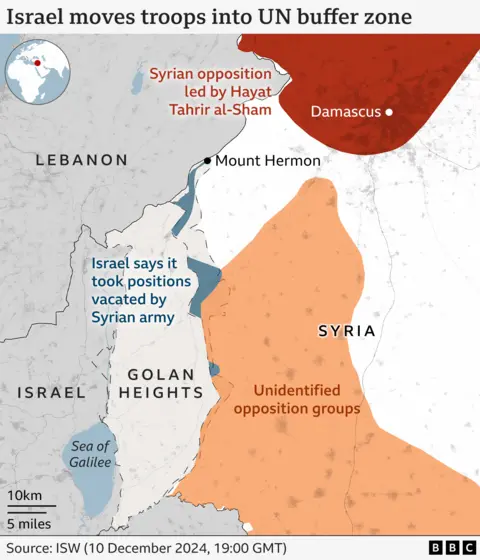
UN peacekeepers remain in the buffer zone established in Syrian territory following the 1973 Middle East War and have stressed that by moving its ground forces in, Israel is now in violation of the ceasefire agreement which set it up.
Israeli officials argue that the ceasefire agreement has now collapsed, as the other party to the agreement ceased to exist, and that its moves are temporary and limited for self-defence.
A UN peacekeeping spokesperson said peacekeepers were “unable to move freely within the buffer zone following recent events”, adding that it was “imperative that the UN peacekeepers are allowed carry out their mandated tasks without hindrance”.
“We’re against these types of attacks. I think this is a turning point for Syria. It should not be used by its neighbours to encroach on the territory of Syria,” UN spokesperson Stephane Dujarric said.
Qatar, Saudi Arabia, Kuwait, Jordan, Iraq and the Arab League have all issued official statements, with several presenting it as a land grab made by taking advantage of recent events, and a violation of Syria’s sovereignty and international law.
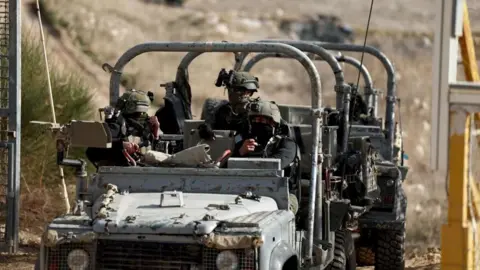 EPA
EPAFrance and Germany have also criticised Israeli actions, with France demanding Israel withdraw troops from the buffer area and Germany warning Israel along with Turkey to Syria’s north not to jeopardise the chances of a peaceful transition in Syria.
“We must not allow the internal Syrian dialogue process to be torpedoed from the outside,” said Foreign Minister Annalena Baerbock.
The US has urged Israel to ensure its incursion is “temporary”.
Among Israelis however there has been broad public support for the country’s pre-emptive actions.
Several media outlets are stressing the potential danger posed by Syria’s new Islamist leaders, with HTS still widely designated as a terrorist organisation.
In the Yedioth Ahronoth newspaper, Amihai Attali congratulated Israel’s military and political establishments, saying they had learnt a valuable lesson from the deadly Hamas attacks of 7 October 2023, which caught the country off guard.
“One of the most important lessons of the invasion, massacre and mass-kidnappings is that we cannot afford the privilege of trying to interpret enemy intentions,” he wrote.
“We can’t afford to make mistakes on that front. We don’t have the margin of error for that.”


Leave a Reply